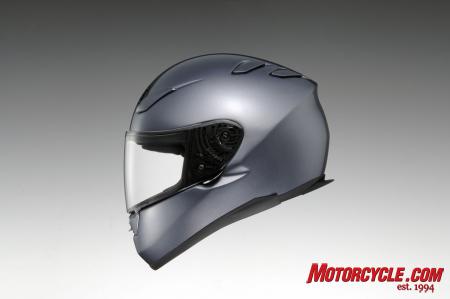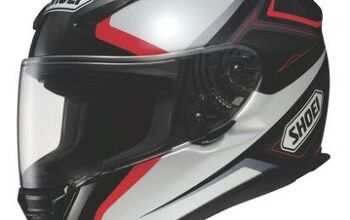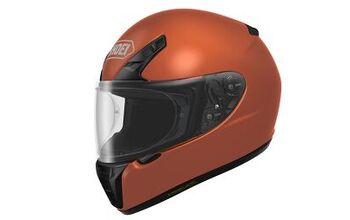Shoei RF1100 Helmet Review
The first good fitting, high-quality helmet I owned was the RF1000 from Shoei. It had the perfect combination of size, weight, decent venting – and most important to me – interior shape.
I guess I have one of those pointy foreheads (trouble along the birth canal?), so a lot of lids I’ve worn and sampled often leave me with an annoying hotspot on the upper part of my forehead. The RF was one of the first helmets to break the cruel cycle.
For the first time since the RF1000’s 2003 inception, Shoei has updated the helmet to the RF1100 for 2010.
The new RF not only improves on desirable features in the 1000, but also incorporates new technology establishing it as an all-new helmet set apart from the previous model.
Shoei makes this new lid in what the company says is an industry-leading five shell sizes: XXS to XXXL. The RF1000 only offered four shell sizes. The new RF1100 also meets the new Snell M2010 standard.
New shell-forming technology created during the development of Shoei’s VFX-W motocross helmet allowed elimination of the plastic wing/spoiler found on the rear of the RF1000.
Shoei says this new technology incorporates the aerodynamic advantages of a spoiler into the shell of the helmet while maintaining consistent shell thickness to guarantee proper strength and weight. The general premise behind most spoilers (whether on a helmet or the rear of a sports car) is to help reduce lift during high-speeds.
The new helmet features three intake and six exhaust vents.
Shoei’s wind tunnel testing revealed exhaust vents work better when located higher on the rear portion of the helmet. On the new 1100, rear exhaust vents moved up and are now separate from the spoiler for what Shoei says is improved venting along with better aerodynamics.
Part of the helmet’s venting system is the Anti-Condensation Shield Ventilation System.
SoCal weather is usually void of humidity, so I didn’t think I’d have much opportunity to fog up my lens until I found myself on a cold, wet ride in Italy. The Anti-Condensation system worked fairly well, but weather was so nasty and my breathing so heavy, it couldn’t eliminate fogging completely.
However, part of Shoei’s base plate system includes a one-handed-operation lens adjuster, aka the Preset Opening Lever.
Placing the preset lever (located on the left base plate) in the down position allows a rider to open the lens just slightly for additional airflow to reduce or eliminate fogging. The preset lever also has a setting that locks the shield closed to prevent unwanted opening during high-speed antics – or, Heaven forbid, a crash!
After years of wearing budget-minded helmets that required some type of tool (usually a quarter if I had one in my pocket, which wasn’t often) to remove the shield, I thought the RF1000’s tool-less shield removal system was divinely inspired. With the lens fully open, just pull a small lever on the hinge/base plate, and in a few seconds the lens is off. Brilliant!
Shoei called that lens removal technology QRBP, or Quick Release Base Plate.
On the RF1100 the system is now called the QRSA (Quick Release Self-Adjusting), and it goes one step further.
The hinge/release system eliminates the need to adjust base plates for proper sealing, as every time the shield is lowered the spring-loaded base plates pull the shield back into contact with the beading around the eye port for a wind and waterproof seal.
Snapping in a dark-tint lens is more challenging, as it’s virtually impossible to see the pieces line up. Attaching a clear lens is easier since the underlying mechanism is readily seen.
Frugal types looking to swap lenses from the old RF1000 beware: The RF1100’s all-new CW-1 shield is both wider and taller than the CX-IV that it replaces so don’t bother migrating a lens from the 1000 to the 1100.
Shoei says the new CW-1 shield protects riders from 99% of the sun’s damaging UVA and UVB rays, and also provides distortion-free vision.
The CW-1 shield also works in conjunction with Shoei’s optional Pinlock system: an anti-fog liner, for lack of a better term, for the interior side of the lens. The new CW-1 Pinlock lens is larger, and is said to offer fog-free viewing to the very top of the helmet’s now larger eye port.
Also larger is the chin bar, which Shoei says is in response to customer requests for more room in that area in order to ease getting the helmet past the nose.
To the best of my knowledge the larger chin bar isn’t less or more safe than a smaller chin bar. However, purely for aesthetics reasons, I prefer the RF1000’s smaller chin bar.
As advertised, though, the increased room allowed more clearance for my schnoz –especially noticeable when removing the lid.
The RF1100 is equipped with a removable, washable, and replaceable center pad and multi-layer cheek pads.
When I remarked earlier that I often get a hotspot on my forehead, the other part of my fit equation I didn’t mention was that I also have a narrow jaw. Getting a helmet with proper/comfortable forehead fit usually means more clearance than what is desirable between my cheeks and the helmet’s cheekpads.
Thankfully the RF1100’s multi-layer cheek pads are available in six different thicknesses to allow a more custom fit. My size medium 1100 has the correct fit for my forehead, but by moving up one cheekpad-size from standard improved the helmet’s overall fit.
Although I didn’t note the 1100 as exceptionally quieter than the 1000, or a few other high-end lids I’ve worn, it certainly is quieter than less expensive helmets.
In my experience chin curtains do seem to reduce wind noise as well as keep the helmet warmer during cool weather; and to a lesser degree they help block out small debris or dust from wafting up inside.
The RF1100’s EPS liner accommodates eyeglass arms via a small gap between the upper part of the cheekpads and the lowest part of the centerpad. Although I don’t wear eyeglasses, I often wear sunglasses in my helmets, and found sliding my shades on and off much easier in the RF1100 when compared to other helmets I have that don’t boast this feature.
Finally, a quick weigh-in on my Dualit kitchen scale saw 3 pounds, 12 ounces for the new RF1100.
As one of the top brand-name motorcycle helmet manufacturers Shoei’s standards for fit and finish are high. Overall quality on the all-new RF1100 is excellent, and the high-luster shell paint is just one indicator of the caliber of helmet Shoei’s 50 years of experience allows them to make.
The RF1100 is offered in an array of colors and graphics and comes with a 5-year limited warranty.
RF1100 Pricing:
- Solid Colors: $399.99
- Metallic Colors: $419.99
- Graphics: $499.99
More by Pete Brissette


































Comments
Join the conversation